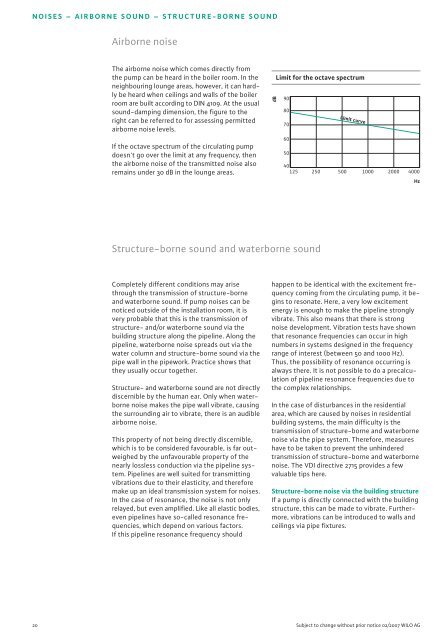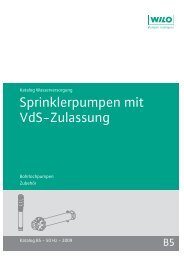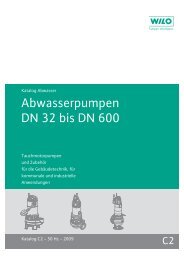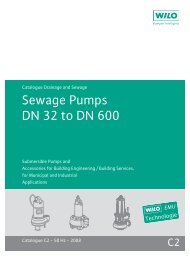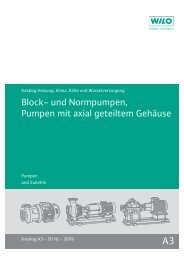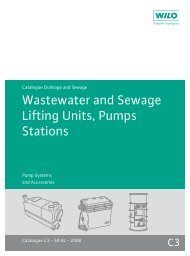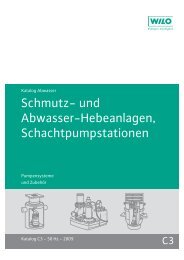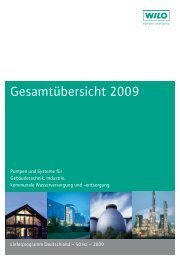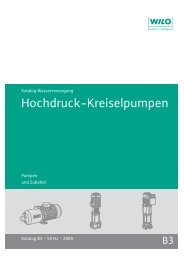Refrigeration, air-conditioning and cooling technology - 2007.pdf
Refrigeration, air-conditioning and cooling technology - 2007.pdf
Refrigeration, air-conditioning and cooling technology - 2007.pdf
Create successful ePaper yourself
Turn your PDF publications into a flip-book with our unique Google optimized e-Paper software.
PLH_KKK_U2_31.QXP 25.05.2007 11:02 Uhr Seite 20NOISES – AIRBORNE SOUND – STRUCTURE-BORNE SOUNDAirborne noiseThe <strong>air</strong>borne noise which comes directly fromthe pump can be heard in the boiler room. In theneighbouring lounge areas, however, it can hardlybe heard when ceilings <strong>and</strong> walls of the boilerroom are built according to DIN 4109. At the usualsound-damping dimension, the figure to theright can be referred to for assessing permitted<strong>air</strong>borne noise levels.If the octave spectrum of the circulating pumpdoesn't go over the limit at any frequency, thenthe <strong>air</strong>borne noise of the transmitted noise alsoremains under 30 dB in the lounge areas.dBLimit for the octave spectrum9080706050Limit curve40125 250 500 1000 2000 4000HzStructure-borne sound <strong>and</strong> waterborne soundCompletely different conditions may arisethrough the transmission of structure-borne<strong>and</strong> waterborne sound. If pump noises can benoticed outside of the installation room, it isvery probable that this is the transmission ofstructure- <strong>and</strong>/or waterborne sound via thebuilding structure along the pipeline. Along thepipeline, waterborne noise spreads out via thewater column <strong>and</strong> structure-borne sound via thepipe wall in the pipework. Practice shows thatthey usually occur together.Structure- <strong>and</strong> waterborne sound are not directlydiscernible by the human ear. Only when waterbornenoise makes the pipe wall vibrate, causingthe surrounding <strong>air</strong> to vibrate, there is an audible<strong>air</strong>borne noise.This property of not being directly discernible,which is to be considered favourable, is far outweighedby the unfavourable property of thenearly lossless conduction via the pipeline system.Pipelines are well suited for transmittingvibrations due to their elasticity, <strong>and</strong> thereforemake up an ideal transmission system for noises.In the case of resonance, the noise is not onlyrelayed, but even amplified. Like all elastic bodies,even pipelines have so-called resonance frequencies,which depend on various factors.If this pipeline resonance frequency shouldhappen to be identical with the excitement frequencycoming from the circulating pump, it beginsto resonate. Here, a very low excitementenergy is enough to make the pipeline stronglyvibrate. This also means that there is strongnoise development. Vibration tests have shownthat resonance frequencies can occur in highnumbers in systems designed in the frequencyrange of interest (between 50 <strong>and</strong> 1000 Hz).Thus, the possibility of resonance occurring isalways there. It is not possible to do a precalculationof pipeline resonance frequencies due tothe complex relationships.In the case of disturbances in the residentialarea, which are caused by noises in residentialbuilding systems, the main difficulty is thetransmission of structure-borne <strong>and</strong> waterbornenoise via the pipe system. Therefore, measureshave to be taken to prevent the unhinderedtransmission of structure-borne <strong>and</strong> waterbornenoise. The VDI directive 2715 provides a fewvaluable tips here.Structure-borne noise via the building structureIf a pump is directly connected with the buildingstructure, this can be made to vibrate. Furthermore,vibrations can be introduced to walls <strong>and</strong>ceilings via pipe fixtures.20 Subject to change without prior notice 02/2007 WILO AG


